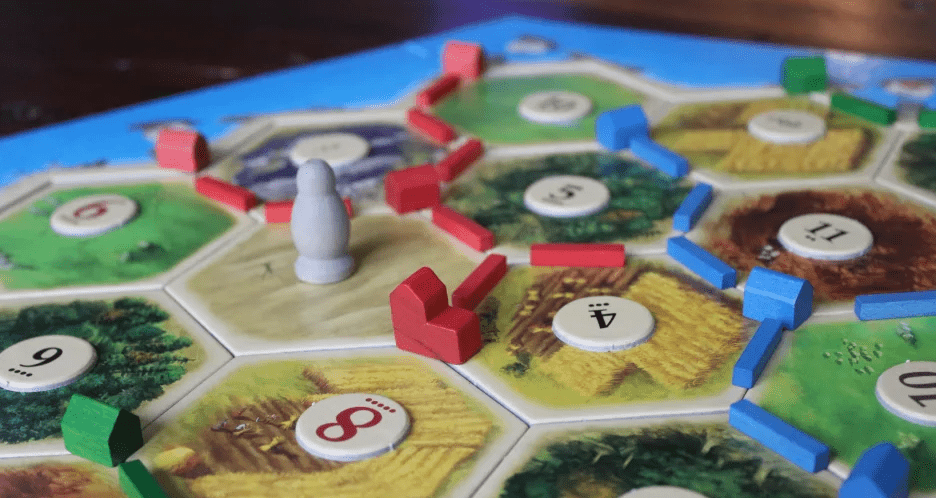Board Game Mechanics – Automatic Resource Growth
The automatic resource growth mechanic in board games is a mechanism that automatically generates resources for players over the course of the game, typically through a set of predetermined rules or conditions. This can take the form of regular income, bonuses for certain actions, or resource production based on the state of the game board.
The purpose of the automatic resource growth mechanic is to provide players with a steady flow of resources, helping to ensure that the game does not stall or become too dependent on one particular strategy or action. This mechanic can also add an element of strategy, as players must decide how best to allocate and utilize their resources. Examples of games that use automatic resource growth mechanics include Puerto Rico, Settlers of Catan, and Agricola.
Here are ten board games with the automatic resource growth mechanic and a brief description of each:
- Agricola: A classic worker placement game where players manage a farm and try to grow crops and raise animals. Each round, players receive a set amount of resources that increase as the game progresses.
- Dominion: A deck-building game where players use their cards to collect resources and build their deck. Players start with a small deck of cards and add to it each turn, gradually increasing their resources.
- Puerto Rico: A game where players manage a colony on the island of Puerto Rico. Each round, players choose a role that provides them with resources, which increase as the game progresses.
- Terraforming Mars: A game where players take on the role of corporations working to terraform Mars. Players receive resources each turn that increase over time, allowing them to build infrastructure and make the planet more habitable.
- Splendor: A game where players collect gemstones to purchase development cards that provide victory points. Players receive a set amount of resources each turn, which increase as they purchase more cards.
- Catan: A game where players compete to settle the island of Catan. Players receive resources each turn based on the placement of their settlements and cities, with resources increasing as the game progresses.
- Scythe: A game set in an alternate 1920s Europe where players compete for resources and territory. Players receive resources each turn based on the actions they take, with resources increasing as the game progresses.
- Roll for the Galaxy: A dice-rolling game where players build a space empire. Players start with a small pool of dice that increase over time, allowing them to build structures and collect resources.
- The Castles of Burgundy: A game where players build their estates and compete for victory points. Players receive resources each turn that increase as the game progresses, allowing them to build more structures and acquire more points.
- Power Grid: A game where players build and manage power plants to provide electricity to cities. Players receive income each turn that increases over time, allowing them to expand their power grid and earn more money.
Overall, these games feature automatic resource growth mechanics that provide players with a steady supply of resources over time, allowing them to build their strategies and make strategic decisions as the game progresses. These mechanics can help make the games more accessible to newer players while still offering a high level of depth and complexity for experienced players.
There are several variations of the automatic resource growth mechanic in board games:
Linear Resource Growth: In this variation, players receive a set amount of resources every turn, for example, 1 gold coin per turn.
Non-Linear Resource Growth: In this variation, players receive a variable amount of resources based on other factors in the game, such as the number of settlements they control or the number of mines they own.
Resource Caps: This variation involves setting a limit on the maximum amount of resources a player can accumulate, which forces players to spend their resources and make choices about how to use them.
Resource Conversion: In this variation, players can convert one type of resource into another, for example, turning wood into stone or vice versa.
Dynamic Resource Generation: In this variation, resources are generated based on the actions of players and other events in the game, making the amount and type of resources generated each turn unpredictable.
Each variation of the automatic resource growth mechanic can add different layers of strategy and decision-making to a game, and can affect the pace, balance, and difficulty of the game.
One example of the automatic resource growth mechanic in a popular board game is Settlers of Catan. In the game, players build settlements, cities, and roads on a board made up of hexagonal tiles representing different resources such as ore, wheat, brick, and sheep. Each turn, players roll two dice to determine which resources are generated, with the number on the dice corresponding to the resource produced by the tiles.
For example, if a player rolls a 7, they get to take all of the resources generated by any tile with a 7 on it. This mechanic ensures that resources are generated automatically each turn, allowing players to collect them and use them to build and expand their settlements.

